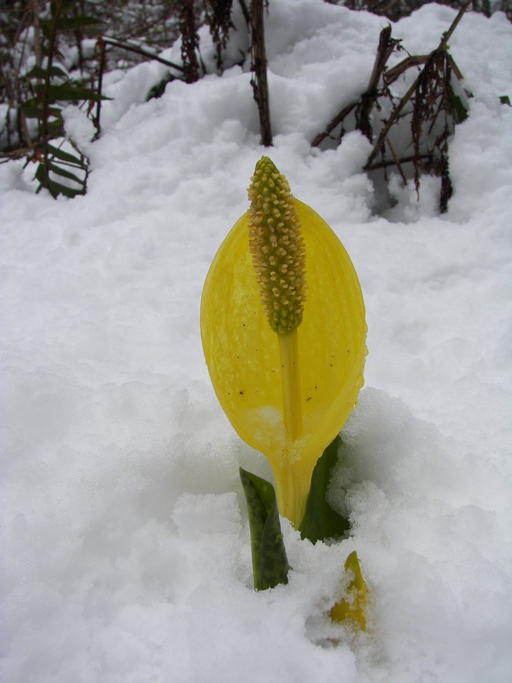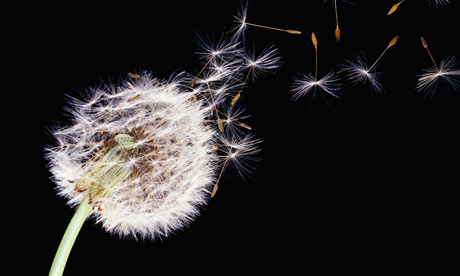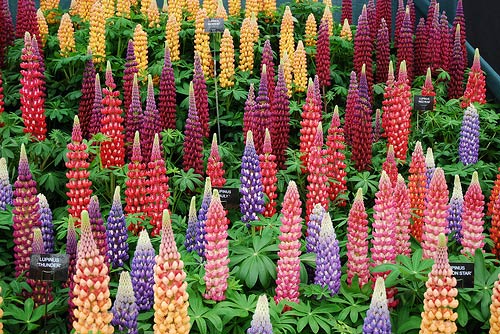SKUNK CABBAGE

Western Skunk Cabbage (Lysichiton americanus)
is an unmistakable plant that many northwesterners are familiar with. It can be
found in several areas of the Arboretum and in moist swampy areas on campus.
The leaves of
Skunk Cabbage are the biggest of any plant in our region. They can be
1.5 to almost 5 feet in length. Native
Americans used the leaves like wax paper to wrap up salmon and to
line baskets for berry gathering. The leaves were eaten only in lean times when
other food was scarce.

The individual flowers of Skunk Cabbage are actually small.
They are the little nibs arranged in circles on the central spike, which looks
vaguely like a pineapple. This structure is called a spadix and is a
distinguishing feature of plants in the familyAraceae. Forming
a bright yellow hood around the spadix of a Skunk Cabbage is the spathe.
Skunk Cabbage mainly grows where the soil is wet– near streams and in boggy places. It
is one of the earliest blooming
plants in the Pacific Northwest as well as campus.
The coolest thing about Skunk Cabbage is that it actually
heats itself. A chemical reaction in the cells of Skunk Cabbage’s flowers produce heat, which helps the plant melt through snow and ice as it grows in spring.

The flowers do give off a skunky smell, although it isn’t
very powerful. The smell attracts
insect pollinators. Chief among these pollinators is the beetle Pelecomalius
testaceum, which apparently specializes on Skunk Cabbage, as well as
various flies.
Another interesting thing about Skunk Cabbage is its roots.
Spreading out from the central stem, the light colored bundle of roots looks a
lot like large earthworms. Like earthworms, the roots have little ridges which
contract slightly, pulling the plant down into the earth a fraction of an inch
each year. After years of wriggling, the underground stem of mature skunk
cabbages can grow anywhere from two to twelve inches long!
If it is not disturbed in its natural habitat, a skunk
cabbage plant may live for a very long time. No one know for sure how old a
skunk cabbage can get, but some researchers believe the largest ones could be
hundreds of years old!
Although at times used for food skunk cabbage contains calcium
oxalate crystals, which create a burning sensation when eaten. This protects
the plant from large predators.
Even though parts of the plant are toxic, skunk cabbage is
also known for its healing agents. In the past, American Indians would smell
the crushed leaves of the plant as a cure for headaches. They made the raw root
into a cream to relieve pain and swelling from muscle aches, and boiled a small
amount of the root to make cough syrup and tea.
STINGING NETTLE

Stinging nettle or common nettle (Urtica dioica) is common all over the
Pacific North West. It can be found in several areas on campus and is fairly
abundant down in the Arboretum. They prefer areas with moist soil and high
concentrations of nitrogen. Stinging nettles are a fascinating plant because of
their medicinal benefits as well as their painful stings.
 Nettle toxin is not fully understood. The nature of the
toxin secreted by nettles has been contested for some time. A nettle stings by
puncturing the outer layer of skin with small glasslike hypodermic needles
filled with a complex toxin. The
stinging hairs of most nettle species contain formic acid, serotonin and various histamines; however recent studies of a New Zealand nettle implicates oxalic acid and tartaric acid rather
than any of those substances, at least in that species. What makes a nettles
sting so potent and painful is still being researched. While normally harmless,
in high enough concentrations, nettle toxin can cause paralysis and a shutdown
of the central nervous system.
Nettle toxin is not fully understood. The nature of the
toxin secreted by nettles has been contested for some time. A nettle stings by
puncturing the outer layer of skin with small glasslike hypodermic needles
filled with a complex toxin. The
stinging hairs of most nettle species contain formic acid, serotonin and various histamines; however recent studies of a New Zealand nettle implicates oxalic acid and tartaric acid rather
than any of those substances, at least in that species. What makes a nettles
sting so potent and painful is still being researched. While normally harmless,
in high enough concentrations, nettle toxin can cause paralysis and a shutdown
of the central nervous system.
While the toxic nature may scare some, nettles are widely
used as a form of medicine for various ailments. Some people deliberately
applying stinging nettles to the skin in order to provoke inflammation. This is
done as a folk remedy for rheumatism,
providing temporary relief from pain. Nettle leaf is a herb that has a long
tradition of use as an adjuvant remedy in the treatment of arthritis in
Germany. Nettle leaf extract contains active compounds that reduce inflammatory cytokines.
It has been demonstrated that nettle leaf lowers cytokines levels by
potently inhibiting the genetic transcription factor that activates them
in the tissue that lines the joints.
Because it contains tetrahydrofuran, certain
extracts of the nettle are used by bodybuilders in an effort to increase free testosterone by
occupying sex-hormone binding globulin.
Stinging nettle has a flavour similar to spinach and
cucumber when cooked and is rich in vitamins A, C, iron, potassium, manganese,
and calcium. Young plants were harvested by Native Americans and
used as a cooked plant in spring when other food plants were scarce. Soaking
nettles in water or cooking will remove the stinging chemicals from the plant,
which allows them to be handled and eaten without incidence of stinging.

DANDELIONS

It would be impossible to live in the Norwest or go to
college her at the UW without seeing a plethora of these pesky little forbs. They
are easily recognized by their bright, golden yellow flower, the deeply
indented ground hugging leaves, and a hollow stem containing a harmless,
bitter, milky juice. The dandelion usually comes out in early spring, as soon
as the leaves begin to show. Interestingly for a plant that is so common and
widespread it is not native to the Pacific Northwest. It came with the European
settlers to the New World and now the hardy perennial forb is generally found across
all of North America.
Dandelions are resilient for a number of reasons. Its long,
thick, tough, carrot-like root can burrow up to three feet underground making
it difficult to eradicate. The flower head is not one Bloom, but are made up of
hundreds of min-flowers, each independent of one another. The blossoms at the
end of the stem turn into white, fluffy seed balls. They then blow off into all
directions, spreading their seeds and finding root for the next year. The seeds
are conceived without pollination or fertilization.

The leaves grow in a flat, rosette arrangement and only the
hollow stalk shoots up to the present what appears to be a single blossom.
Dandelions have an incredible built-in clock which is controlled by light, the
flowers close each evening and to open again at sunrise.
For those on campus looking for a cheap meal, Dandelions are
the perfect choice. The leaves can be plucked anytime, they are best in the
early spring before the flower blooms and the leaves turn bitter. The spring
roots are also tender. The best salads are made with fresh picked leaves, and should
be seasoned like any other salads. They are somewhat tangy and chewy. The young
leaves can also be cooked like spinach and served with the main course.
As the season progresses, the fall roots are much stronger.
If you wash and dry the roots, then shred it in a blender, you can make
dandelion tea. If you roast the ground roots, you can make your own gourmet
coffee substitute. Wine can even be made from dandelions.
The dandelion was one of the more than 2000 herbs that were
used when the settlers came from England. The roots have been used in tonics
and liver cures, as well as to stop infections, skin diseases,
dropsy, and to settle the digestive tract. Dandelion juice was credited with
removing warts, blisters, freckles and growing hair on bald heads and eyebrows.
Because it is non-native, indigenous people never utilized it.
Dandelions are an excellent source of vitamin A,
some B, and contains proteins, calcium, iron, sodium, phosphorous and a decent
amount of vitamin C, magnesium and potassium.
White Clover
White
clover likes to grow in fields and disturbed areas and can be identified by its
tri-leaf structure, and the white “V” shape on its leaves. The white clover has been used for thousands
of years for various different purposes.
It is a member of the legume family, and as such makes a great nitrogen
fixing crop in agriculture. Native
Americans used the white clover leaves to make a tea that help with colds. Today white clover can be used to help a
number of different ailments including bronchial coughs, whooping coughs, and pertussis. It is said to be an overall proponent of
strength and health and a great calming agent.
 You
can eat the flowers which have a sweet taste because of their honey, and the
young leaves as long as the flowers have not yet bloomed. Bees love this plant, and consequently beekeepers will sometimes place their beehives in a field of clover to make clover honey. When ingesting white clover, be careful that
no part of the plant has been damaged or wilted because this can allow for a
toxin to produce that can be harmful. As
mentioned before both the leaves and flowers make a healthy tea, and the
flowers can make a tasty addition to salads and breads.
You
can eat the flowers which have a sweet taste because of their honey, and the
young leaves as long as the flowers have not yet bloomed. Bees love this plant, and consequently beekeepers will sometimes place their beehives in a field of clover to make clover honey. When ingesting white clover, be careful that
no part of the plant has been damaged or wilted because this can allow for a
toxin to produce that can be harmful. As
mentioned before both the leaves and flowers make a healthy tea, and the
flowers can make a tasty addition to salads and breads.
Lupine
 Lupines are common to North
America and are a member of the legume family which means they are a nitrogen
fixing plant. Their flowers can be pink,
purple, blue, yellow or white, and they can grow to around 26 inches. The seeds of the lupines were loved by the
Romans who spread the plant throughout the Roman Empire. The name Lupine comes from the Latin word lupines,
which means wolf. They were named for
the way which the lupines would ravage the land like wolves, and perhaps that the
lupine peas were said to be fit only for consumption by wolves.
Lupines are common to North
America and are a member of the legume family which means they are a nitrogen
fixing plant. Their flowers can be pink,
purple, blue, yellow or white, and they can grow to around 26 inches. The seeds of the lupines were loved by the
Romans who spread the plant throughout the Roman Empire. The name Lupine comes from the Latin word lupines,
which means wolf. They were named for
the way which the lupines would ravage the land like wolves, and perhaps that the
lupine peas were said to be fit only for consumption by wolves.  Despite the Sweet Lupine’s popularity as a
source of dietary fiber and in Lupine Pasta, it is commonly
believed that lupines are often toxic to humans because of the alkaloids they
produce, and are on the list for foodstuff allergens. It is generally recommended to refrain from
consuming this plant, especially if you suffer from a peanut allergy.
Despite the Sweet Lupine’s popularity as a
source of dietary fiber and in Lupine Pasta, it is commonly
believed that lupines are often toxic to humans because of the alkaloids they
produce, and are on the list for foodstuff allergens. It is generally recommended to refrain from
consuming this plant, especially if you suffer from a peanut allergy. 

I like that you guys included edible forbs. I didnt know people ate dandelions and how much nutritional value they had. Very neat!
ReplyDelete-Nikki
Great information on stinging nettles.
ReplyDelete-Skylar